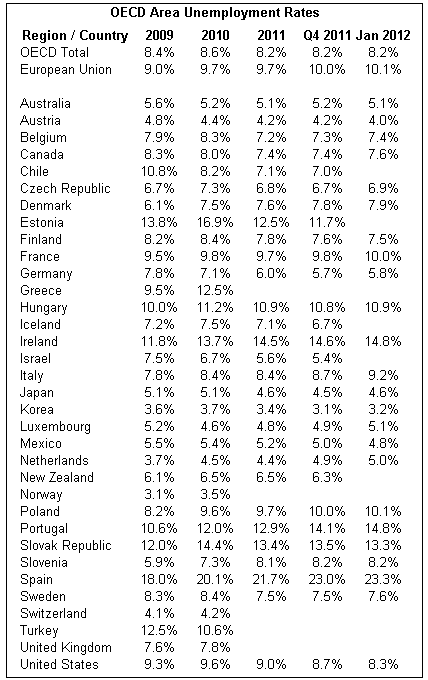IDEX Online Research: OECD Area Unemployment Stable in January
March 22, 12 by Ken Gassman
(IDEX Online News) – The unemployment rate for most of the world’s developed economies – the OECD area – remained stable in January at 8.2 percent. This was in line with the annual unemployment rate of 8.2 percent in 2011, but below the unemployment rate for 2009 of 8.4 percent and 2010’s 8.6 percent. Clearly, the global employment situation is improving.
Within the OECD area – which includes North America, Europe (West and East), the U.K. and Ireland, Australia and New Zealand, Scandinavia, and Israel – there was some divergence in unemployment trends.
· In the Euro area, unemployment climbed slightly to 10.7 percent in January, up from December’s 10.6 percent.
o In Austria and the Slovak Republic, the unemployment rate fell. Austria posted a 4.0 percent unemployment rate in January, while the Slovak Republic’s unemployment rate fell to 13.3 percent from the mid-13 percent level late last year.
o Unemployment was stable in Denmark (7.9 percent), Finland (7.5 percent), Luxembourg (5.1 percent) and Slovenia (8.2 percent).
o All other Euro area countries posted a slightly higher unemployment rate for January, on a seasonally adjusted basis. Spain’s unemployment rate stands at 23.3 percent, the highest in the Euro area, while Germany, with the largest Euro economy, has an unemployment rate of 5.8 percent.
· The unemployment rate is Australia fell slightly to 5.1 percent and in Mexico to 4.8 percent. Canada’s unemployment rate also fell slightly to 7.4 percent.
· The U.S. unemployment rate of 8.3 percent in January was stable with December, following five consecutive months late last year when its unemployment rate declined.
· Japan’s unemployment rate rose slightly to 4.6 percent in January, and Korea’s rose slightly to 3.2 percent. However, these unemployment rates are considered “full employment,” so the trend is not worrisome.
The table below summarizes the unemployment rate trends for OECD countries. Unfortunately, non-OECD regions are not included; this would include China, Russia, Asia, South America and the Middle East (with the exception of Israel, which is an OECD member and reports economic data).

Source: OECD |

